Toronto Mayor John Tory’s recent announcement that construction of the relief subway line serving downtown Toronto might be advanced by two years was met with universal praise by transit and construction advocates.
But the proposed new timetable, with Tory saying the estimated $7-billion project could be completed by 2029, must be assessed against a backdrop of uncertainties, past failures and potential obstacles, the advocates said.
Potential hitches identified could arise from the province’s plan to study uploading Toronto’s subways, which could mean the relief line would compete with other projects Premier Doug Ford has supported in the past, and from proposed plans to have the private sector build subway stations, which could leave transit projects subject to the vagarities of the real estate market.
“I am totally supportive of this and if we can do that faster I think it is definitely the priority now,” commented Martin Collier, founder of Transport Futures.
“But with uploading, that could delay things.”
Transit advocacy group TTCriders said in a statement it welcomed the announcement and also warned the province’s plan to upload the subway system could cause delays to the relief line.
“The province’s plan to steal our subway system risks delaying the relief line and transit in Scarborough,” said TTCriders’s spokesperson Shelagh Pizey-Allen.
“We can’t leave new transit lines at the whim of real estate markets. The province needs to fund transit properly, not break it apart.”
The Residential and Civil Construction Alliance of Ontario (RCCAO) launched a public awareness campaign highlighting the need for the relief line last year after there was a dangerous overcrowding incident at the Bloor-Yonge subway station on the Yonge-University-Spadina line in January 2018.
To have it done by 2029 and people riding it, I find it hard to believe they will meet that timeline,
— Martin Collier
Transport Futures
“We are pleased because this fits with our campaign to ensure the relief line is the top transit priority for the region,” said RCCAO executive director Andy Manahan, who noted that at one point last year the premier discussed other subway extensions including into Vaughan.
“I think (Transportation Minister Jeff) Yurek has said pretty loud and clearly that the relief line is a top priority and he recognizes that because of the overcrowding issue the sequence should be relief line first and extension of another line later.
“The relief line has wider regional benefits and it is the type of line that will benefit suburban riders even more than downtown riders.”
Tory made the announcement Jan. 17 at the Pape subway station. He said advancing the timing of the relief line is a frequent topic of discussion at transit planning meetings.
“Earlier this month, staff came back with a plan to get the relief line up and running two years earlier than the original 2031 date,” Tory said.
The TTC plans to include $162 million in its 2019 budget submission to ensure early works on the relief line can begin this year but otherwise the broader project is not yet funded. The new funding proposal will be discussed at the TTC board meeting today (Jan. 24).
The relief line would run north-south through east Toronto, offering commuters another path to get in and out of the downtown.
Tory said measures identified to advance the timetable include accelerating design work, speeding up property acquisitions, doing utility locates and starting the procurement process early to obtain necessary technical construction equipment.
Manahan said the RCCAO has advocated for standardized station designs to speed up design and save on costs. He suggested the plan proposed by Tory indicated a potential streamlining or rescheduling of typical environmental assessments.
Long-time Toronto transit analyst Ed Levy, retired former president of the board of directors for BA Consulting Group Ltd. and a 60-year observer of Toronto transit planning, acknowledged the challenge the city faces in expediting relief line delivery.
“The very slow bureaucratic standard procedure for approving and building subways, surely the most costly and complicated category of infrastructure in any city, would have to be reformed with several phases being undertaken simultaneously, as I believe the mayor is envisaging,” he said.
Levy noted many of Tory’s predecessors have made similar promises but the relief line has remained elusive. He commented, “The largest elephant in the closet is and always will be funding. Where might the billions of dollars needed be found?”
Collier said he was wary about the new timeline, especially whether a northern second phase could be completed.
“They have to take it north of Eglinton to really have a difference,” he said. “That phase, to have it done by 2029 and people riding it, I find it hard to believe they will meet that timeline.
“If they can, that’s good but they will have to keep that as a priority in the GTA, they can’t be distracted by Scarborough subways or Pickering subways or even the Yonge line before that’s in.”
Collier expressed skepticism of the province’s proposed subway uploading plan.
“To go through the governance uploading, just the subways, it is too complicated and too much energy,” he said. “If the government just provided the money to the city, that would be better. But I don’t think the people in Thunder Bay want to pay for Toronto subways. I think it should stay at the local level with provincial support.”










Recent Comments
comments for this post are closed